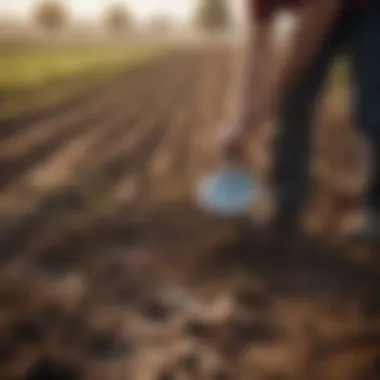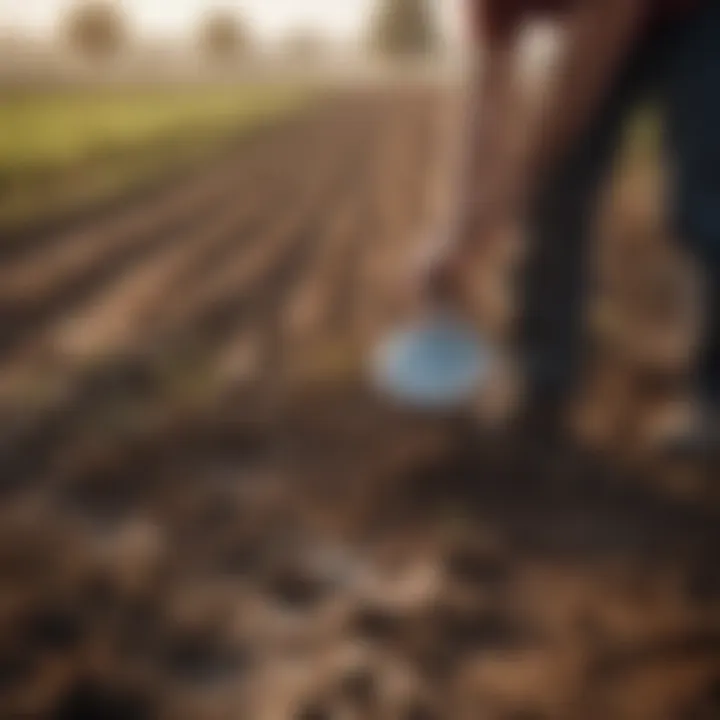The Importance of Water in Agriculture and Sustainability


Intro
Water is not just a mere resource in agriculture; it is the lifeblood that sustains every seed, plant, and crop. Without it, agricultural practices would come to a halt, and entire ecosystems could be jeopardized. The significance of water in farming transcends irrigation techniques and delves into climate resilience, socio-economic impacts, and innovative management strategies. This article takes a closer look at how water plays a critical role in agriculture, emphasizing its importance in crop production, addressing sustainability challenges, and exploring the tools and technologies that can help farmers efficiently utilize this precious resource.
Key Concepts and Terminology
One must grasp some key terms and concepts to understand fully the intricate relationship between water and agriculture.
Basic Definitions
- Irrigation: The artificial application of water to soil or land, aimed at aiding in the growth of crops. For instance, drip irrigation delivers water directly to the roots of plants, maximizing efficiency and minimizing waste.
- Water Scarcity: A situation where the demand for water exceeds the available supply, leading to significant challenges in agricultural productivity and sustainability.
- Sustainable Practices: Agricultural methods that do not deplete natural resources or harm ecological balance, allowing water and land to be preserved for future generations.
Historical Context
The utilization of water in agriculture has evolved dramatically over centuries. Ancient civilizations recognized the importance of river systems for irrigation. The Mesopotamians, for example, developed extensive irrigation systems using the Tigris and Euphrates rivers as lifelines for their crops. Over time, as technology advanced, methods shifted from simple flood irrigation to more sophisticated practices, like center pivot irrigation systems that revolutionized farming efficiency and productivity.
Recent Innovations and Trends
In today’s changing world, innovation is at the forefront of addressing water challenges in agriculture.
Technological Advancements
Modern technology has transformed how farmers approach water usage:
- Smart Irrigation Systems: These include sensors and automated timers that adjust watering schedules based on weather conditions and soil moisture levels, ensuring optimal water usage.
- Rainwater Harvesting: Innovative techniques have emerged for collecting and storing rainwater for irrigation during drier periods, helping reduce dependency on groundwater.
Sustainable Practices
With increasing awareness of environmental issues, sustainable practices play a crucial role in agriculture. Farmers are adopting:
- Conservation Tillage: Reducing soil disturbance maintains moisture in the ground, decreasing the need for constant irrigation.
- Crop Rotation: Growing different crops in succession improves soil health and reduces water pressure by minimizing the demand on the same land.
Practical Applications and Techniques
For farmers and enthusiasts eager to apply these principles, a hands-on approach can make a world of difference.
Step-by-step Guides
- Implement Rainwater Harvesting:
- Optimize Irrigation Techniques:
- Engage in Crop Rotation:
- Identify suitable storage solutions such as barrels or tanks.
- Ensure gutters collect rainwater effectively to direct it into storage.
- Set up a filtration system to keep the water clean for use.
- Assess the current watering method and identify potential improvements.
- Experiment with smart irrigation systems.
- Plan out crop cycles for the next few years to maintain soil health while managing water usage.
Case Studies
Take the example of Dr. Ana Gonzalez, a farmer in California who faced severe water shortages. By implementing moisture sensors and transitioning to drip irrigation, her water usage decreased by 35%, significantly reducing waste while improving crop yields.
"Innovative water management is more than just a necessity; it's a lifeline for sustainable farming. Without adaptability, drought can spell disaster for many communities."
As we explore the significance of water in agriculture, it’s evident that working together—using technology, sustainable practices, and sound management strategies—can help forge a resilient future for farming. The journey to efficient water use in agriculture is ongoing, with promising advancements lighting the path for tomorrow's farmers.
Understanding the Importance of Water in Agriculture
Water is the lifeblood of agriculture. Without it, crops simply won't survive. The importance of water extends beyond just being a vital resource; it shapes the livelihoods of farmers around the globe and plays a critical role in food security. Each step of agricultural practices—be it planting, growing, or harvesting—revolves around effective water management.
Defining Agricultural Water Use
Agricultural water use refers to the deliberate application of water for cultivating crops and raising livestock. This encompasses various activities such as irrigation, livestock watering, and processing agricultural products. In terms of scale, agricultural water use is hugely significant; in many countries, it accounts for over 70% of total freshwater withdrawal. Hence, understanding how and when to use water efficiently can make a world of difference.
Water use can be categorized in several ways:
- Irrigation Water Use: This includes water diverted from natural sources for agricultural purposes, primarily to enhance crop yield.
- Rainfed Water Use: It involves utilizing rainfall to meet crop water needs, relying on nature's cycles.
- Wastewater Reuse: More recently, reclaiming wastewater for irrigation is gaining traction, promoting sustainability in farming practices.
Historical Context of Water Use in Agriculture
Diving into the history of agricultural water use reveals fascinating insights about human civilization. Ancient farmers understood the significance of water long before modern practices appeared. In places like Mesopotamia, farmers built sophisticated irrigation systems around 5000 B.C. They diverted river water to manage seasonal floods better and ensure crop growth during dry spells. Many cultures established reliable methods for harnessing water, as seen in the rice paddies of Southeast Asia, where intricate water management techniques emerged.
Fast forward to today, the growing demands for water due to increased population and changing climates have posed significant challenges. Historical practices inspire current innovations, where historical techniques marry modern technology to promote efficient water usage. In a world facing climate uncertainties, returning to fundamental water management practices offers invaluable insights into sustainable agriculture.
As we explore this subject, it's essential to recognize that the relationship between water and agriculture is dynamic. Each drop not only nourishes the soil but also holds the potential to impact food systems, economies, and communities worldwide.
Sources of Water for Agricultural Use
Understanding where water comes from is fundamental for agricultural practices. The sustainability of crop production hinges largely on the availability and management of different water sources. Water plays a vital role, not just ensuring plants grow, but also in affecting the overall health of the ecosystem. The significance of sustainable water sourcing cannot be understated, especially as climate change makes water availability increasingly unpredictable.
Surface Water Resources
Surface water comprises bodies of water like rivers, lakes, and reservoirs. Each of these sources offers unique advantages and presents specific challenges in irrigation practices.
Rivers
Rivers act as natural arteries for water, flowing across landscapes and often cradling human settlements along their banks. Their continuous flow can be a dependable source for irrigation. A key characteristic of rivers is their dynamic nature—they can replenish significantly during rainy seasons. This means farmers often rely on rivers for timely access to water.
However, there’s a double-edged sword effect here. The benefits come alongside challenges like erosion and seasonal floods, which can disrupt agricultural plans unexpectedly. Farmers must tread carefully, understanding the river dynamics for optimal crop planting and irrigation.


Lakes
Lakes provide a more stagnant water option. This quality allows for easier management and storage, particularly in areas where rainfall is inconsistent. One distinct feature of lakes is their capacity to store larger amounts of water over time, which can be crucial during dry seasons.
On the flip side, relying on lakes can present challenges, such as potential contamination from agricultural runoff or urban drainage. Therefore, maintaining water quality is paramount for farmers using lakes as their primary water source.
Reservoirs
Reservoirs are like man-made lakes designed to store water for various uses, including irrigation. They are often created behind dams and provide a controlled water supply, making them a popular choice for farmers needing consistent access.
The unique feature of reservoirs is their ability to capture excessive rainwater and provide it during dry spells. A challenge here is the initial investment and environmental impact in creating these reservoirs. Additionally, they may lead to reduced water flow downstream, affecting ecosystems and farmers relying on that natural flow.
Groundwater Extraction
Groundwater is another crucial aspect of agricultural water sourcing, drawn primarily from aquifers and wells.
Aquifers
Aquifers are underground layers of water-bearing rock or sediment that store significant amounts of water. They're essential for farmers in regions where surface water is scarce. A key characteristic of aquifers is their capacity to sustain water supply over time, as they can be recharged with proper management practices. Farmers tapping into aquifers often find a more stable water source through varying seasons.
But not without a caveat—over-extraction of groundwater can lead to depletion and land subsidence. It’s a delicate balance; sustainable practices are needed to ensure aquifers serve future generations without compromise.
Wells
Wells provide a direct method for extracting groundwater. They can be dug or drilled, offering farmers immediate access to water beneath the ground. The main advantage of wells is their flexibility; wells can be established based on the specific needs of a farm and can be used when surface water is limited.
However, a drawback includes the potential for contamination if proper safeguards are not put in place. Also, depending on location, digging a well may require substantial resources, both time and capital.
Rainwater Harvesting
Rainwater harvesting serves as an innovative approach to water management, particularly in regions facing water scarcity. This practice involves collecting and storing rainwater from rooftops or other surfaces for later use.
The beauty of rainwater harvesting is its dual purpose: it alleviates the demand on existing water sources while enhancing sustainability. It’s cost-effective and promotes environmental stewardship, making it an attractive option for modern farmers striving for a balanced approach to agriculture. Some challenges exist, such as the seasonal nature of rainfall and the necessity for proper storage methods to prevent contamination.
In summary, understanding the sources of water available for agricultural use is essential for enhancing productivity and ensuring resilience under climate change conditions. This insight empowers farmers to make informed decisions that contribute to sustainable practices in agriculture.
Irrigation Methods in Agriculture
Irrigation stands as a fundamental aspect in the agricultural landscape, shaping how and when water reaches crops. The method of irrigation chosen can significantly influence yield, resource efficiency, and the sustainability of the farming practice itself. Importantly, it forms a bridge between mere crop survival and flourishing agricultural success. Adopting suitable irrigation techniques not only benefits farmers but also has wider implications for food security, especially in water-scarce regions.
Traditional Irrigation Techniques
Flood Irrigation
Flood irrigation is a time-honored method that involves saturating the entire field with water. This technique's greatest strength lies in its simplicity — it requires minimal equipment, making it an accessible option for many farmers. Often considered cost-effective, flood irrigation can be beneficial for large fields, particularly in regions with ample water supply.
However, flood irrigation has its drawbacks. The key characteristic of this method involves the uniform distribution of water over the crop surface, which sounds like a win-win, right? Well, not always. The unique feature of flood irrigation is that it can lead to significant water wastage. During periods of high saturation, water can run off the fields, potentially causing soil erosion and nutrient runoff, which diminishes soil health over time.
"Proper management and timing in flood irrigation can alleviate some disadvantages, but the inherent risks remain."
Canal Systems
Canal systems represent another traditional approach to irrigation, where channels are constructed to convey surface water to agricultural lands. This method is particularly valued in areas where water bodies are naturally present. The benefit of using canal systems is that they can facilitate large-scale irrigation efficiently. They are often designed with precision, allowing for regulated water flow tailored to the field's needs.
On the flip side, the construction and maintenance of such systems require considerable investment and ongoing labor. One cannot disregard the unique challenge posed by canal systems, namely the potential for water loss through evaporation or seepage into the ground. Farmers must carefully weigh the advantages of ample water access against the costs and labor involved in maintaining the canal infrastructure.
Modern Irrigation Systems
Drip Irrigation
Drip irrigation emerges as a game-changing technology in contemporary agricultural practices, promoting efficiency like never before. This system delivers water directly to the roots of plants through a network of tubing and emitters, ensuring that water is applied where it's needed most. The key characteristic of drip irrigation lies in its precision. This targeted delivery method minimizes waste and reduces the risk of over-watering.
Given climatic pressures and the escalating need for sustainable farming, drip irrigation is increasingly seen as a valuable choice. It dramatically enhances water use efficiency, enabling farmers to manage their resources conscientiously while improving crop yields. However, it’s crucial to note that the initial setup costs can be quite high, posing a barrier for some growers.
Sprinkler Systems
Sprinkler systems also play a vital role in modern irrigation, delivering water through a series of pipes and hoses that spray water much like natural rainfall. This method is popular for its versatility in varied climates and soil types. The key feature of sprinkler irrigation is its adaptability; it can be used for practically any type of crop, from grains to fruits.
Nevertheless, sprinkler systems come with their share of disadvantages. They often lead to significant water evaporation during hot summer months, which can undermine their efficiency. Moreover, they might require higher energy inputs, making them less environmentally favorable in certain situations.
Choosing the Right Irrigation Method
When it comes to settling on an irrigation method, farmers face the challenge of balancing multiple factors: resource availability, cost efficiency, crop needs, and environmental impact. Assessing the unique characteristics and specifics of each method aids in making informed decisions.
Understanding local climatic conditions, soil types, and water availability can provide insightful direction in choosing the optimal irrigation technique. Some farmers may even find blending techniques to be useful. For example, using both drip and flood irrigation in tandem, or employing a combination of traditional and modern systems can cater to a wider array of agricultural demands, ultimately leading to a sustainable and productive farming practice.
Water Efficiency in Agriculture
Water efficiency in agriculture is more than just a trendy topic among modern farmers; it's a necessity. With the stark realities of climate change, increasing population, and economic pressures, every drop of water counts. Efficient use not only maximizes crop yield but also conserves vital resources, ultimately paving the way for sustainable practices. Simply put, water is the lifeblood of agriculture, and understanding how to use it wisely can differentiate between thriving and merely surviving in the farming world.
Accurate measurement, innovative strategies, and the integration of technology have become essential components in this domain. Not to forget, the economic angle plays a significant role. With rising water costs, ensuring that farmers get the most out of their water resources is critical. This section dives deep into measuring water use efficiency and outlines best practices for fostering a culture of conservation in agriculture.
Measuring Water Use Efficiency
Measuring water use efficiency (WUE) is the backbone of sustainable agriculture. It refers to the amount of crop produced per unit of water used, a vital metric for assessing whether water is being utilized effectively. Essentially, understanding WUE helps in identifying areas of improvement in irrigation methods, soil management, and crop selection.
Farmers can use various techniques to measure their water efficiency:
- Crop Yield per Acre: Calculating the output in bushels or tons for each inch of water applied.
- Soil Moisture Sensors: Monitoring soil moisture levels in real-time allows farmers to adjust irrigation schedules accordingly, thus preventing over-watering or under-watering.
- Irrigation Central Control Systems: These systems can provide data on the efficiency of water delivery systems and help in making immediate adjustments.


By focusing on these measurements, farmers can make data-driven decisions, leading to tangible improvements in water resource management.
Best Practices for Efficient Water Use
Implementing best practices for efficient water use can dramatically enhance agricultural productivity. Here’s a closer look at two key strategies that practitioners often turn to:
Soil Moisture Management
Soil moisture management plays a crucial role in optimizing water usage in agriculture. It revolves around monitoring and maintaining the right levels of moisture in the soil to ensure crops can absorb water effectively without wastage.
An important characteristic of soil moisture management is its adaptability; it can be tailored to various crops and climatic conditions. The key technique involves using soil moisture sensors that inform farmers of when to irrigate, allowing crops to draw in moisture as they need it.
Some advantages of this technique include:
- Improved crop yield due to optimal watering.
- Reduced water waste, making farming more sustainable.
However, a notable disadvantage can be the initial setup cost and learning curve associated with new technology, especially for traditional farmers.
Crop Rotation
Crop rotation is another effective practice that contributes to water efficiency. This method involves alternating the types of crops grown in a particular area across seasons. It has the remarkable characteristic of improving soil health and reducing reliance on chemical fertilizers and pesticides.
By planting different crops that have varying root structures and nutrient requirements, farmers can enhance water retention in the soil. For instance, deep-rooted plants can help break up compacted soil layers, allowing for better water infiltration.
Some unique features include:
- Enhanced biodiversity, which promotes a balanced ecosystem.
- Potential reduction in soil erosion since different root systems help hold soil together.
However, a drawback can be the need for significant planning in crop cycles, which may not suit every farming style.
Emphasizing a mixed approach by combining soil moisture management with crop rotation can utilize water resources effectively, paving the way for future sustainable practices.
Sustainability Challenges Associated with Water Use
Water is the lifeblood of agriculture, but with its critical role comes a series of intricate sustainability challenges that cannot be overlooked. Farmers and agricultural enthusiasts must grapple with the reality that, even though water is abundant, its management is far from simple. Addressing these sustainability challenges is crucial not only for improving yields but also for ensuring that future generations can continue to produce food without exhausting our valuable resources.
Water Scarcity Issues
In many parts of the world, water scarcity has reached alarming levels. This scarcity can be attributed to several factors including population growth, increased demand for food, and inefficient water management practices. Farmers feel the impact firsthand as they face diminishing water supplies, which complicates irrigation schedules and crop viability.
- Regional Variability: Not all regions face the same level of scarcity. In places like the California Central Valley, agricultural production has significantly dropped due to prolonged droughts. Conversely, some areas have seen floods but struggle with water storage and management.
- Inefficiencies in Usage: Often, outdated irrigation techniques waste more water than they conserve. Flood irrigation practices, while traditional, can lead to substantial water loss through evaporation and runoff.
"Water scarcity isn't just about lack of water; it's about how we manage what we have."
These challenges push farmers to rethink their water usage strategies, adapting more efficient practices that can better balance supply and demand.
Impact of Climate Change on Water Availability
Climate change acts like a double-edged sword when it comes to water availability. On one hand, it brings about changes in precipitation patterns, leading to excessive rainfall in some areas and prolonged droughts in others. On the other hand, it accelerates evaporation rates, further stressing already limited water resources.
- Changing Rainfall Patterns: Many regions that previously relied solely on seasonal rains are now seeing unpredictable fluctuations. Droughts can stretch longer and be more severe, while heavy downpours can lead to soil erosion and water runoff, reducing soil moisture levels where crops need it most.
- Rising Temperatures: Increased temperatures can heighten the evapotranspiration process, reducing the effectiveness of rainfall and irrigation efforts. In essence, crops need more water as conditions escalate.
These shifts necessitate that farmers develop adaptive strategies to mitigate the impacts of climate variability. Improved water management systems and the adoption of smarter farming techniques become essential to maintaining agricultural productivity.
Socio-Economic Implications of Water Management
Water management in agriculture is not just about keeping crops hydrated; it’s about weaving the very fabric of society itself. In many regions, particularly in developing countries, the way water resources are managed can profoundly affect economic stability, social equity, and food production systems. If we don't pay attention, the consequences can ripple through entire communities, altering livelihoods and even fuelling conflicts.
Effects on Food Security
Food security hinges on having enough water for agriculture. When farmers can’t access quality water, whether due to scarcity or poor management, their yields drop. This isn't just a farmer's problem; it becomes a community issue. Food supplies dwindle, leading to higher prices and increasing hunger rates. In rural areas, where many people rely on subsistence farming, an inability to irrigate can mean dire consequences for entire families.
A striking fact is that about 80% of the world’s freshwater is consumed for agricultural purposes. When managing water resources, the goal should be to ensure that food systems remain resilient. This can involve:
- Implementing irrigation technologies that minimize wastage.
- Diversifying crop choices so that farmers can switch to less water-intensive varieties during drought.
The upsides of proper water management are clear—it can create a buffer against droughts and disasters while stabilizing food prices. According to various studies, regions investing in efficient water practices saw a significant increase in agricultural output.
Water Rights and Agricultural Equity
In many areas, the topic of water rights is as contentious as it is crucial. Access to water can dictate who thrives and who struggles in agriculture. Without clear policies, conflicts arise among different user groups—large agribusinesses, smallholder farmers, and even local communities.
Agricultural equity is essential for sustainable water use. It’s not just about the resource; it’s also about how it's divvied up. Ensuring that all farmers have fair access to water resources, regardless of their economic status, fosters a healthier agricultural landscape. This requires robust policies that prioritize disadvantaged groups.
To promote a fairer system, communities can consider:
- Creating cooperative water management systems.
- Engaging stakeholders in discussions about water rights.
- Implementing regulations that protect the most vulnerable farmers.
"Water management goes beyond supply; it paves the way for food security and equitable agricultural practices."
Through meticulous planning and the active involvement of farmers, the outcomes of effective water management can forge a path towards sustainable agricultural prosperity.
Innovative Practices for Sustainable Water Use
Innovative practices for sustainable water use are at the forefront of modern agricultural techniques. As water scarcity becomes a pressing issue globally, implementing cutting-edge solutions is crucial for ensuring that our agricultural systems remain productive while minimizing environmental impacts. These innovations not only strive to enhance water efficiency but also aim to address the pressing challenges posed by climate change and population growth.
Technological advancements play a significant role in this context. They provide farmers with the tools necessary to utilize water more effectively, ultimately fostering a smarter approach to resource management. Moreover, from simple community-driven initiatives to complex technological solutions, adapting these practices can lead to a more sustainable future for agriculture.


Technological Advancements
Smart Irrigation Systems
Smart irrigation systems epitomize the marriage of technology and agriculture. These systems adjust water application based on real-time data, such as soil moisture and weather forecasts. One of the standout features is their ability to minimize water waste by delivering precise amounts where and when it's most needed.
This method is increasingly popular among farmers looking to cut costs while increasing yield. By ensuring that crops receive optimal water levels, smart irrigation contributes directly to higher production rates and healthier plants. However, farmers need to consider the initial investment costs and the complexity of installation. While these systems offer numerous advantages—including reduced labor and water use—their affordability and ease of use vary widely.
"Adopting smart irrigation can lead to water savings of up to 50%!"
Soil Sensors
Another breakthrough in efficient water management comes from soil sensors. These devices measure the moisture levels of the soil, helping farmers understand when to irrigate. The key characteristic of soil sensors is their capability to offer accurate, real-time feedback about soil conditions, which is vital for effective water management.
By utilizing soil sensors, farmers can optimize their irrigation schedules based on actual soil moisture needs instead of relying on guesswork or predetermined watering times. This evidence-based approach ensures crops are not over or under-watered. Although the technology can be a little pricey, the advantages—such as improved crop yield and reduced water consumption—often justify the initial outlay.
Policy and Community Initiatives
Engaging in policy and community initiatives can magnify the effects of innovative practices for sustainable water use. Local governments and agricultural bodies can create frameworks supporting sustainable water policies. Likewise, community-driven efforts can promote water conservation techniques and education among local farmers, turning knowledge into action.
A few examples of community initiatives include:
- Organizing workshops on efficient irrigation techniques.
- Promoting the sharing of water resources among farmers.
- Developing community rainwater harvesting systems.
Policy changes, such as grants for sustainable farming practices, can also encourage more farmers to adopt these innovative methods. As communities band together and enact such measures, the impact can ripple throughout the agricultural sector, securing a more sustainable water future.
Global Perspectives on Agricultural Water Use
Understanding the global perspectives on agricultural water use is essential in addressing the multifaceted challenges faced in different parts of the world. Water plays an undeniable role in agriculture, dictating crop yield, sustainability, and efficiency in farming practices. As agricultural demands grow due to population increases, the approach to water resources has become a crucial factor that influences not only local economies but also global food security.
Comparison of Water Use in Different Regions
Water usage in agriculture varies widely across countries and regions, shaped by environmental factors, socio-economic conditions, and technological advancements. In some areas, like parts of California and India, agricultural irrigation consumes the lion’s share of water resources.
- High-Consumption Regions: In arid and semi-arid regions, such as North Africa and the Middle East, farmers heavily rely on irrigation to sustain their crops. Here, the National Water Authority plays a pivotal role, setting guidelines that aim to balance agricultural and urban needs. The reliance on surface water and groundwater has been alarmingly high, leading to depletion.
- Moderate-Use Regions: Countries like Brazil operate with a more dynamic approach. Irrigation in Brazil is extensive, but the use of rainfed agriculture remains significant. Diverse climatic conditions allow for various practices. This versatility presents opportunities for sustainable practices, which might be less feasible in high-consumption regions.
- Low-Consumption Regions: In northern European countries, water resources are highly managed. A mix of rainfall, innovative irrigation techniques, and crop selection minimizes water need while maximizing yield. Farmers here often employ precision agriculture, integrating technology for optimal efficiency.
"Water is life, and in agriculture, it's the elixir of growth and prosperity."
This comparison shows that while some areas immoderately draw from their water sources, others successfully employ sustainable methods. Understanding these disparities equips policymakers and practitioners with insights that lead to more efficient management of water resources across the board.
International Policies on Water Management
International policies play a significant role in shaping water management practices in agriculture. Guidelines established by organizations like the Food and Agriculture Organization (FAO) and the United Nations aim to ensure equitable access to water resources, promote sustainable use, and bolster agricultural productivity.
Several frameworks exist:
- The FAO Guidelines: These guidelines encourage countries to integrate water management into broader agricultural policies. They focus on resource conservation, urging nations to enhance their water governance systems.
- The UN Watercourses Convention: This convention aims to prevent disputes over shared water resources. It provides a crucial framework for transboundary water cooperation, fostering agreements that accommodate agricultural needs while respecting conservation principles.
- Regional Initiatives: Various regions—like the European Union with its Water Framework Directive—have implemented cohesive policies that link water management to agricultural practices. By doing this, member states work in harmony to address water scarcity while promoting agricultural efficacy.
Moreover, collaboration between nations is indispensable. Countries can share best practices and technologies for managing agricultural water use. Global perspectives highlight not just struggles with scarcity but also the potential for innovation and cooperation that could uplift agricultural practices universally.
Future Trends in Agricultural Water Use
The landscape of agriculture is continuously evolving, influenced by a mix of technological advancements, climatic shifts, and changing consumer demands. Understanding the importance of future trends in agricultural water use is essential for farmers and agricultural enthusiasts to ensure not just survival but also thrive in the modern agricultural era. One of the main benefits of focusing on these trends is that it helps in efficient resource allocation, making sure that every drop of water is utilized wisely.
Moreover, as water scarcity becomes more pronounced globally, adapting to these trends is vital for sustaining productivity and meeting food security goals. With a thorough grasp of what lies ahead, stakeholders in the agricultural sector can better prepare for challenges.
Forecasting Water Demand in Agriculture
Forecasting water demand in agriculture is akin to peering into a crystal ball; it requires an understanding of both historical data and future projections. This process often involves analyzing various factors like climate conditions, crop types, and technological innovations.
- Climate Impact: Changing temperatures and increased unpredictability in rainfall patterns significantly affect how much water different crops will require.
- Technological Solutions: Innovations such as predictive modeling and satellite technology are being used to project future water needs accurately. Farmers can now make more informed decisions based on real-time data rather than relying solely on traditional methods.
These forecasting techniques are immensely valuable, enabling farmers to allocate water resources efficiently, avoid waste, and mitigate risks associated with droughts or excessive rainfall.
Integrating Water Management with Sustainable Practices
Integrating water management with sustainable practices is no longer just a preference; it is a necessity. For many, it involves a cultural shift in how to perceive water as a crucial resource, rather than merely a commodity.
- Soil Health: Better water management ultimately leads to enhanced soil health. Practices like cover cropping and mulching can help retain moisture, thus reducing the need for excessive irrigation.
- Crop Selection: Farmers are increasingly opting for drought-resistant crops. This choice not only ensures yield stability but also further conserves water resources.
Proper integration fosters a holistic approach to agriculture. Achieving sustainability in water management can lead to long-term productivity gains and environmental preservation.
"The future of agriculture lies not just in what we grow, but how efficiently we manage our resources."
Ending and Key Takeaways
In summing up the vital role water plays in agriculture, it becomes evident that without this precious resource, farming as we know it would cease to exist. Water is not merely a resource; it is the lifeblood of crops, the key that unlocks agricultural potential. Farmers across the globe are often faced with the daunting task of managing water efficiently—as the relationship between water availability and agricultural productivity is intricate and paramount. An understanding of water dynamics in farm practices can lead to improved crop yields and sustainability.
Summarizing the Importance of Water in Agriculture
Water acts as the backbone of agricultural practices. It influences every stage of crop growth, from seed germination to harvest. Without adequate water, crops can’t flourish. Moreover, water is integral in soil health; it impacts nutrient uptake and microbial activity, which are essential for crop development. Poor water management can lead to salinization and degradation of land, putting future farming at risk.
Farmers must recognize the specific water requirements of their crops. For instance, corn and rice require a much more substantial amount of water compared to sorghum or millet, which are more drought-resistant. Thus, the importance of tailoring water usage according to what’s being grown cannot be overstated. Furthermore, different irrigation methods have distinct efficiency rates—fixed systems may work in one region but fall short in another due to varying climates or soil types.
Call to Action for Sustainable Water Practices
Farmers and policymakers alike must commit to sustainable water practices. The pressing issue of water scarcity is a battle that can be mitigated through proactive measures. Policies that promote rainwater harvesting or incentives for adopting efficient irrigation technologies like drip and sprinkler systems can change the game.
Raising awareness about the importance of these practices at community levels is equally crucial. Education can empower farmers to adopt methods that conserve water.
- Maintain soil health by utilizing cover crops and composting to improve water retention.
- Engage in crop rotation to diversify and enhance resilience against drought.
- Seek out community partnerships to share insights on water management and technology.
"Sustainable water management is the gateway to a resilient agricultural future—not just for farmers, but for society as a whole."
In light of these considerations, embracing innovative water practices will not just bolster agricultural output but also safeguard resources for future generations. Through diligent action, the agriculture sector can thrive within its water limitations, ultimately crafting a sustainable future.















